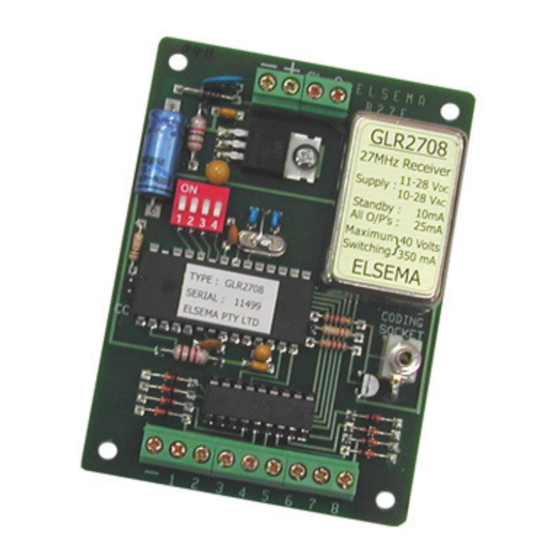
Table of Contents
Advertisement
Quick Links
GLR2708
8-Channel 27MHz Gigalink™ Receiver with Open Collector Outputs
Features
• Wide supply connection – 10.0 to 28.0 Volts AC/DC
• Highly sensitive receiver input stage. When used with GLT27.... series
transmitters and an ANT27L antenna, an operating range of 350 metres
(980 ft) is possible.
• Eight open collector outputs. All outputs can be operated
simultaneously.
• Crystal controlled for high stability and performance.
• Uses micro-controller technology that can be re-programmed
to suit unique applications.
• Momentary, latching and security latching output modes is user
selectable.
Applications
• automatic gates, security, timer controlled outputs and simple on/off functions etc.
Description
The GIGALINK™ is an advanced Remote Control technology available in the world today. GIGALINK™ is
an invention that has revolutionised the entire Remote Control technology including Elsema's earlier version of
FMT- ... and FMR- ... series.
The GLR2708 series state-of-the-art invention brings a new dimension in the world of Remote Control
technology in domestic, commercial and industrial applications.
The innovative microcontroller technology replaces the traditional dip switch coding which eliminates any
possible code grabbing. Special features such as over four billion code combinations and ability to program any
number of transmitters to a receiver adds up to the most advanced and secure Remote Control available
Code Programming
For code programming, please refer to the separate programming instructions.
8-Channel 27MHz GIGALINK™ Receiver with open collector outputs, GLR2708
- 1 -
ELSEMA
Advertisement
Table of Contents

Subscribe to Our Youtube Channel
Summary of Contents for Elsema Gigalink GLR2708
- Page 1 Description The GIGALINK™ is an advanced Remote Control technology available in the world today. GIGALINK™ is an invention that has revolutionised the entire Remote Control technology including Elsema's earlier version of FMT- … and FMR- … series. The GLR2708 series state-of-the-art invention brings a new dimension in the world of Remote Control technology in domestic, commercial and industrial applications.
- Page 2 Security - Output remains active until power to the receiver is removed. Similar to security alarms and fire alarms. Latching Customised Software Custom output modes can be programmed to do special functions. Call Elsema for more details. - 2 -...
- Page 3 The ULN2803 IC is available from Elsema. Output 1 being at the left and output eight to the right of the terminal block. Unique Code System The microcontroller EEPROM allows large volume users to have a unique code.
- Page 4 8-Channel 27MHz GIGALINK™ Receiver with open collector outputs, GLR2708 Technical Data 10.0 to 28 V AC/DC. Absolute maximum DC 40 Volts Can use Elsema 12-volt AC power pack (PP12) Supply Voltage Supply lines should be less than 3 metres long to comply with radio frequency authorities Current Consumption 14mA standby, 22mA if all outputs “On”...
- Page 5 ELSEMA 8-Channel 27MHz GIGALINK™ Receiver with open collector outputs, GLR2708 Block Diagram - 5 -...
- Page 6 ELSEMA 8-Channel 27MHz GIGALINK™ Receiver with open collector outputs, GLR2708 Application Notes (GLR2708) Care should be taken with the solid-state outputs that they are protected from inductive loads. This is done by connecting diodes across your DC inductive load. Inductive loads such as DC relays must be clamped with a diode across the relay coil. If this is not done the spikes generated by the DC relay can lock-up the receiver.
- Page 7 ELSEMA 8-Channel 27MHz GIGALINK™ Receiver with open collector outputs, GLR2708 REGULATORY COMPLIANCE STATEMENTS American Users This device complies with Part 15 of the FCC Rules. Operation is subject to the following two conditions: (1) This device may not cause harmful interference and (2) This device must accept any interference received, including interference that may cause undesired operation.








Need help?
Do you have a question about the Gigalink GLR2708 and is the answer not in the manual?
Questions and answers